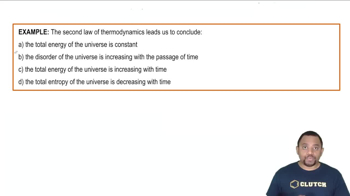Consider the reaction X2(g) → 2X(g). When a vessel initially containing 755 torr of X2 comes to equilibrium at 298 K, the equilibrium partial pressure of X is 103 torr. The same reaction is repeated with an initial partial pressure of 748 torr of X2 at 755 K; the equilibrium partial pressure of X is 532 torr. Find ΔH° for the reaction.
Indicate and explain the sign of ΔSuniv for each process. a. 2 H2(g) + O2(g) → 2 H2O (l) at 298 K.
 Verified step by step guidance
Verified step by step guidance
Verified Solution
Key Concepts
Entropy (ΔS)

Second Law of Thermodynamics

Gibbs Free Energy (ΔG)

Dinitrogen tetroxide decomposes to nitrogen dioxide: N2O4(g) → 2 NO2(g) ΔH°rxn = 55.3 kJ At 298 K, a reaction vessel initially contains 0.100 atm of N2O4. When equilibrium is reached, 58% of the N2O4 has decomposed to NO2. What percentage of N2O4 decomposes at 388 K? Assume that the initial pressure of N2O4 is the same (0.100 atm).
The Haber process is very important for agriculture because it converts N2(g) from the atmosphere into bound nitrogen, which can be taken up and used by plants. The Haber process reaction is N2(g) + 3 H2(g) → 2 NH3(g). The reaction is exothermic but is carried out at relatively high temperatures. Why?
A metal salt with the formula MCl2 crystallizes from water to form a solid with the composition MCl2 • 6 H2O. The equilibrium vapor pressure of water above this solid at 298 K is 18.3 mmHg. What is the value of ΔG for the reaction MCl2 • 6 H2O(s) ⇌ MCl2(s) + 6 H2O(g) when the pressure of water vapor is 18.3 mmHg? When the pressure of water vapor is 760 mmHg?
The solubility of AgCl(s) in water at 25 °C is 1.33⨉10-5 mol/L and its ΔH° of solution is 65.7 kJ/mol. What is its solubility at 50.0 °C?
